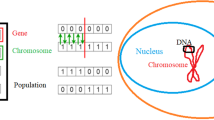Abstract
Signals that carry information regarding the existing defects or possible failures of a system are sometimes difficult to analyze because of various corrupting noises. Such signals are usually acquired in difficult conditions, far from the place where defects are located and/or within a noisy environment. Detecting and diagnosing the defects require then quite sophisticated methods that are able to make the distinction between noises encoding the defects and another parasite signals, all mixed together in an unknown way. Such a method is introduced in this paper. The method combines time-frequency-scale analysis of signals with a genetic algorithm.
Preview
Unable to display preview. Download preview PDF.
Similar content being viewed by others
References
Figueras i Ventura, R.M., Vandergheynst, P., Frossard, P.: Evolutionary Multiresolution Matching Pursuit and its relations with the Human Visual System. In: Proceedings of EUSIPCO 2002, Toulouse, France, September 2002, vol. II, pp. 395–398 (2002)
Mallat, S., Zhang, S.: Matching Pursuit with Time-Frequency Dictionaries. IEEE Transactions on Signal Processing 41(12), 3397–3415 (1993)
Mitchell, M.: An Introduction to Genetic Algorithms. The MIT Press, Cambridge (1995)
Stefanoiu, D., Ionescu, F.: Vibration Faults Diagnosis by Using Time-Frequency Dictionaries. Research Report AvH-FHKN-0301, Konstanz, Germany (January 2003)
Author information
Authors and Affiliations
Editor information
Editors and Affiliations
Rights and permissions
Copyright information
© 2003 Springer-Verlag Berlin Heidelberg
About this paper
Cite this paper
Stefanoiu, D., Ionescu, F. (2003). Faults Diagnosis through Genetic Matching Pursuit. In: Palade, V., Howlett, R.J., Jain, L. (eds) Knowledge-Based Intelligent Information and Engineering Systems. KES 2003. Lecture Notes in Computer Science(), vol 2773. Springer, Berlin, Heidelberg. https://doi.org/10.1007/978-3-540-45224-9_99
Download citation
DOI: https://doi.org/10.1007/978-3-540-45224-9_99
Publisher Name: Springer, Berlin, Heidelberg
Print ISBN: 978-3-540-40803-1
Online ISBN: 978-3-540-45224-9
eBook Packages: Springer Book Archive




